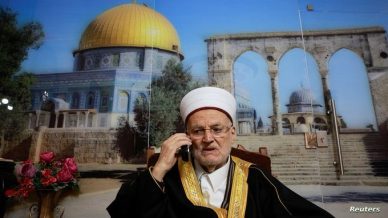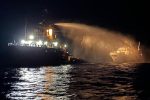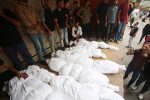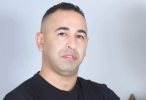At the courtyards of Al-Aqsa Mosque three Palestinians from Um Al-Fahm city carried out a shooting attack on Friday morning July 14 killing two Israeli occupation officers before they were killed at the hands of Israeli policemen.
This shooting was only the latest manifestation of a revolutionary spirit of an Arab-Muslim thought in the hearts of the people of this city located in the heart of the northern 1948 occupied Palestine which for nine decades had shown outstanding courage in defense of Palestine and Al-Aqsa Mosque.
The largest area
Um Al-Fahm is located to the north of the Palestinian Triangle area. It was affiliated with the Jenin province before the Nakba. On the eve of the Nakba the Iraqi forces entered the city and remained there for about a year before handing the city over to the Jordanian forces which handed it over to Israel under the Armistice Agreement of 1949 (Rhodes Agreement). Its inhabitants stayed there and did not leave it.
Um Al-Fahm was the largest city in Palestine with an area of 150000 dunums of which only 22000 dunums remain today. An estimated number of 52000 Palestinians live there today. The city has the second largest Palestinian population in the 1948 Occupied Territories after Nazareth.
The name of the city was associated with coal (Fahm) which was produced in the city in large quantities throughout the ages and because of the trade of coal by its people which was the main source of livelihood for them for generations.
The first time Um Al-Fahm was mentioned in history was in the year 1265 when the famous Muslim leader Al-Zaher Baybars gave it to Prince Jamal Al-Din Akush Al-Nujaibi and its borders reached Caesarea town.
Um Al-Fahm consists of four famous alleys: Mahamid Mahajneh Jabarin and Igbaria. Most of the local families came from the Hebron area namely Beit Jibrin and Tel Safi.
A history of revolution
The people of Um Al-Fahm are proud of their long history of resistance and rejection of colonialism and occupation during which the city continued to breed revolutionaries in defense of Palestine.
During the British colonization of Palestine the people of Um Al-Fahm fought many battles against the colonizers.
The most prominent battles were the Battle of the School which took place between the locals and the British forces on 30 January 1930 and the battle of Ein Zaytouna which took place on 19 September 1938 during which the rebels inflicted heavy losses among the invading troops.
Following its occupation by Israel the city remained a hotbed of constant tension that disturbed the occupation and its security apparatuses because of the strong national spirit and its people’s refusal of subjugation to the occupiers.
There were many clashes between the occupation and the people of Um Al-Fahm most notably in May 1958 the Land Day clashes in 1976 and the Al-Ruha clashes in 1998 following the occupation’s decision to confiscate thousands of dunums of land from the Ruha area of Um Al-Fahm for military training.
Because of its advanced role and the steadfastness of its people and their pride in their Palestinian national identity Israel always viewed Um Al-Fahm as the most ‘extremist’ Arab city in the 1948 Occupied Palestine. The city was the target of aggressive tactics by some Israeli fanatics which aimed at forcing the city’s population to consider deserting it.
The most prominent of such tactics was carried out by the leader of the Kach movement Rabbi Meir Kahana who made a provocative visit to the city in 1984 calling on its population to migrate to Arab countries as well as the two provocative visits made by the right-wing activist Baruch Marzel in 2009 and 2010 to incite against banning the Islamic Movement.
The Sheikh of Al-Aqsa and its supporter
When Um Al-Fahm is mentioned Sheikh Raed Salah the head of the Islamic Movement in the 1948 Occupied Territories and the mayor of Um Al-Fahm for 12 years who dedicated his time and effort to serve and defend Al-Aqsa Mosque comes to mind.
Sheikh Salah’s role in the maintenance of Al-Aqsa Mosque and other holy shrines began to increase in 1996 when he managed to foil many Israeli plans aimed at emptying Al-Aqsa Mosque from worshipers.
Sheikh Salah succeeded in reconstructing the Marwani Mosque and opening its gates. He reconstructed the old Aqsa Mosque cleaning its yards and lighting it setting up toilets and ablution units as well as organizing Quran memorization groups in the terraces of Al-Aqsa Mosque.
He also contributed to the establishment of Al-Aqsa Children Fund which aims to support the reconstruction projects of Al-Aqsa Mosque and link children with the issue of Al-Aqsa Mosque.
Sheikh Salah revived the love of Al-Aqsa Mosque in the hearts of Palestinians in the 1948 Territories by highlighting the Israeli threats against it by organizing an annual carnival called ‘Al-Aqsa in Danger’ which was held in Um Al-Fahm annually and was attended by tens of thousands of Palestinians.
He also revived the Muslim presence at Al-Aqsa Mosque through the March of Banners in which buses from all Arab towns of the 1948 Occupied Territories took part.
Sheikh Salah and several people from Um Al-Fahm paid a heavy price for defending Al-Aqsa Mosque.
In 2000 Um Al-Fahm played a prominent role in the angry protests that followed the then Israeli premier Ariel Sharon’s desecration of Al-Aqsa Mosque. Three young men from Um Al-Fahm were martyred and hundreds were injured in those protests.















